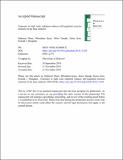Files in this item
Exposure to high solar radiation reduces self-regulated exercise intensity in the heat outdoors
Item metadata
| dc.contributor.author | Otani, Hidenori | |
| dc.contributor.author | Kaya, Mitsuharu | |
| dc.contributor.author | Tamaki, Akira | |
| dc.contributor.author | Goto, Heita | |
| dc.contributor.author | Maughan, Ronald J. | |
| dc.date.accessioned | 2019-11-22T00:37:09Z | |
| dc.date.available | 2019-11-22T00:37:09Z | |
| dc.date.issued | 2018-11-22 | |
| dc.identifier | 256704627 | |
| dc.identifier | 88e2f6f5-86e3-4af7-8347-de0067817e82 | |
| dc.identifier | 85057157180 | |
| dc.identifier | 000456753900024 | |
| dc.identifier.citation | Otani , H , Kaya , M , Tamaki , A , Goto , H & Maughan , R J 2018 , ' Exposure to high solar radiation reduces self-regulated exercise intensity in the heat outdoors ' , Physiology & Behavior , vol. In press . https://doi.org/10.1016/j.physbeh.2018.11.029 | en |
| dc.identifier.issn | 0031-9384 | |
| dc.identifier.other | RIS: urn:FDFED3C9BC1B1718DD3AA2170C6AF4A0 | |
| dc.identifier.uri | https://hdl.handle.net/10023/18983 | |
| dc.description.abstract | High radiant heat load reduces endurance exercise performance in the heat indoors, but this remains unconfirmed in outdoor exercise. The current study investigated the effects of variations in solar radiation on self-regulated exercise intensity and thermoregulatory responses in the heat outdoors at a fixed rating of perceived exertion (RPE). Ten male participants completed 45-min cycling exercise in hot outdoor environments (about 31 °C) at a freely chosen resistance and cadence at an RPE of 13 (somewhat hard). Participants were blinded to resistance, pedal cadence, distance and elapsed time and exercised at three sunlight exposure conditions: clear sky (mean ± SD: 1072 ± 91 W·m−2; HIGH); thin cloud (592 ± 32 W·m−2; MID); and thick cloud (306 ± 52 W·m−2; LOW). Power output (HIGH 96 ± 22 W; MID 103 ± 20 W; LOW 108 ± 20 W) and resistance were lower in HIGH than MID and LOW (P < .001). Pedal cadence was lower, the core-to-skin temperature gradient was narrower, body heat gain from the sun (SHG) was greater and thermal sensation was higher with increasing solar radiation and all variables were different between trials (P < .01). Mean skin temperature was higher in HIGH than MID and LOW (P < .01), but core temperature was similar between trials (P = .485). We conclude that self-regulated exercise intensity in the heat outdoors at a fixed RPE of somewhat hard is reduced with increasing solar radiation because of greater thermoregulatory strain, perceived thermal stress and SHG. This suggests that reduced self-selected exercise intensity during high solar radiation exposure in the heat may prevent excessive core temperature rise. | |
| dc.format.extent | 1839199 | |
| dc.language.iso | eng | |
| dc.relation.ispartof | Physiology & Behavior | en |
| dc.subject | Body temperature | en |
| dc.subject | Exercise performance | en |
| dc.subject | Heat stress | en |
| dc.subject | Thermal sensation | en |
| dc.subject | Sunlight | en |
| dc.subject | RA0421 Public health. Hygiene. Preventive Medicine | en |
| dc.subject | RC1200 Sports Medicine | en |
| dc.subject | QP Physiology | en |
| dc.subject | NDAS | en |
| dc.subject | SDG 3 - Good Health and Well-being | en |
| dc.subject.lcc | RA0421 | en |
| dc.subject.lcc | RC1200 | en |
| dc.subject.lcc | QP | en |
| dc.title | Exposure to high solar radiation reduces self-regulated exercise intensity in the heat outdoors | en |
| dc.type | Journal article | en |
| dc.contributor.institution | University of St Andrews. School of Medicine | en |
| dc.identifier.doi | https://doi.org/10.1016/j.physbeh.2018.11.029 | |
| dc.description.status | Peer reviewed | en |
| dc.date.embargoedUntil | 2019-11-22 |
This item appears in the following Collection(s)
Items in the St Andrews Research Repository are protected by copyright, with all rights reserved, unless otherwise indicated.

